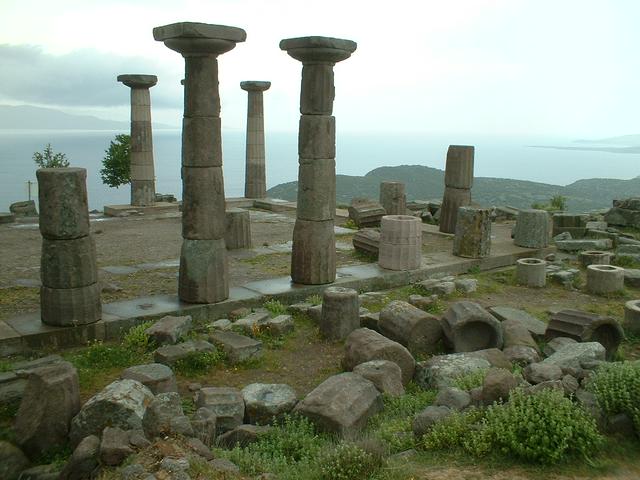Behramkale is a beautiful hillside village of stone-built houses and cobbled alleys in the Turkish region of Northern Aegean, overlooking the turquoise waters of the Gulf of Edremit, facing the northern foothills of the Greek island of Lesvos. The ancient incarnation of the village, Assos, still reveals itself through the ruins of the hilltop Temple of Athena, the defensive city walls still surrounding a good deal of the village's circumference, and numerous other remnants of the olden times.

This is a village that is consisted of two parts: the ‘real’ village on the top of a hill overlooking the sea, and a coastal part right down by the shore (which was the harbour of the village in the past). Both parts are equally old and full of stone buildings with traditional Mediterranean architecture.
The village lived as Behramkale for centuries, and with the advance of tourism in the 20th century, its ancient name of Assos returned back to the surface. Today, highway signs and the like always refer to the village as both (such as Behramkale-Assos), but travelling industry almost always refer to it as Assos only. It appears as Behram on some old maps.
The village was an important centre in ancient times. It had then a philosophy academy run by the famous philosophers Aristotales and Hermaios, a student of Platon.
- Old town. Old part of the town with its grey/granite stone houses and cobbled steep alleys.
- Temple to Athena. This is the major attraction of the village. It dates back to the 6th century BC and has the first ever Doric columns (still standing) built on Asian soil. A splendid place to watch the sun setting in the Aegean Sea. 5 TL/person. No student discounts.
- Old bridge. An old bridge dating back to Ottoman times.
Old town. Old part of the town with its grey/granite stone houses and cobbled steep alleys.
Temple to Athena. This is the major attraction of the village. It dates back to the 6th century BC and has the first ever Doric columns (still standing) built on [[Asia]]n soil. A splendid place to watch the sun setting in the Aegean Sea. 5 TL/person. No student discounts.
Old bridge. An old bridge dating back to Ottoman times.
- You may attend philosophy classes taking place in the village every summer. They choose a different major subject to think and speak about every summer.
- The sea there is unbelievably clean, so swimming is also a good idea.
You may attend philosophy classes taking place in the village every summer. They choose a different major subject to think and speak about every summer.
The sea there is unbelievably clean, so swimming is also a good idea.
There are no supermarkets nor any ATMs in town. Only one of the grocery stores accept credit cards, the one located in the outskirt of the village, on the junction of the roads leading to west (Gülpınar), north (Ayvacık), and east (Küçükkuyu). Some fresh fruits/vegetables in addition to snacks, water, and drinks (alcoholic and soft alike) can be found there.
On the alleys of old town, villagers sell local produce such as thyme freshly picked from mountains around or castile soap at stalls.
There are open-air fish restaurants on the shore and a few modest restaurants in the upper part of the village.
Telephone code of the village is (+90) 286.
- Babakale, some 20 km to the west, on the edge of the peninsula, is a village known for its well-preserved citadel which sits on a cape that is exactly the westernmost point of Asian mainland.
- Zeus Altar (Zeus Altarı), 4 km inland (look for the signpost on the main highway) on the hills above the neighbouring village of Küçükkuyu to east, about 25 km away from Assos, was where offerings to the prime god of Greek pantheon was made in ancient times. Other than a marble base, not much is left from the actual altar, but the place is located in a lush forest and offers commanding views of the Aegean.
Zeus Altar (Zeus Altarı), 4 km inland (look for the signpost on the main highway) on the hills above the neighbouring village of [[Küçükkuyu]] to east, about 25 km away from Assos, was where offerings to the prime god of Greek pantheon was made in ancient times. Other than a marble base, not much is left from the actual altar, but the place is located in a lush forest and offers commanding views of the Aegean.
